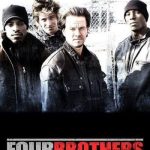RAGING BULL (1980)

Raging Bull, released in 1980 and directed by the legendary Martin Scorsese, is widely considered one of the greatest films of all time. Starring Robert De Niro in an Oscar-winning performance as real-life boxer Jake LaMotta, the movie is an unflinching portrayal of the rise and fall of a deeply flawed man. More than just a boxing film, Raging Bull is a powerful exploration of human frailty, obsession, and the search for redemption.
Plot Overview
Raging Bull tells the story of Jake LaMotta, a middleweight boxer whose raw talent in the ring is matched by his violent temper and self-destructive tendencies outside of it. Set in 1940s and 1950s New York, the film follows LaMotta’s career as he fights his way to the top, becoming a world champion. However, his personal demons, including jealousy, insecurity, and rage, slowly destroy his relationships with those closest to him—his brother Joey (Joe Pesci) and his wife Vickie (Cathy Moriarty).
As LaMotta’s career reaches its peak, his personal life begins to unravel. His paranoia and jealousy over Vickie’s perceived infidelities, as well as his growing estrangement from Joey, lead him down a path of isolation. Eventually, LaMotta’s self-sabotage culminates in the loss of his title, his family, and his dignity. The film concludes with a reflective LaMotta, now overweight and running a nightclub, contemplating his life and mistakes, a shadow of the fighter he once was.
A Cinematic Triumph
What makes Raging Bull stand apart from other sports films is its refusal to glorify its subject. Martin Scorsese and screenwriter Paul Schrader crafted a brutally honest character study of Jake LaMotta, a man whose ferocity in the ring mirrored the chaos of his personal life. The film presents LaMotta’s flaws with an unvarnished authenticity, highlighting his inability to control his temper, his possessiveness, and his insecurity.
Scorsese’s direction is a masterclass in visual storytelling. The film’s decision to shoot in black and white adds a stark, almost documentary-like feel, heightening the sense of realism. The boxing sequences, though few, are visually stunning, filmed with a raw intensity that places the audience inside the ring. Slow motion, unconventional camera angles, and meticulous sound design capture the brutality of the sport, while also serving as metaphors for LaMotta’s internal struggles.
Robert De Niro’s Iconic Performance
Robert De Niro’s portrayal of Jake LaMotta is one of the most iconic performances in film history. To fully embody LaMotta, De Niro underwent a dramatic physical transformation, gaining over 60 pounds to play the boxer in his later years. His commitment to the role earned him the Academy Award for Best Actor, and his portrayal remains a benchmark for method acting.

By the film’s end, LaMotta is no longer a champion, but a man seeking forgiveness for his sins. The final scenes, where he recites Marlon Brando’s famous “I coulda been a contender” speech from On the Waterfront, serve as a reminder that even the mightiest fighters are ultimately human, flawed, and searching for meaning.
Critical Acclaim and Legacy
Upon its release, Raging Bull received widespread critical acclaim. It was nominated for eight Academy Awards, winning two—Best Actor for Robert De Niro and Best Editing for Thelma Schoonmaker, whose sharp, rhythmic cuts are essential to the film’s power. Over time, Raging Bull has been recognized as one of the greatest films ever made, often cited as Scorsese’s finest work and a pinnacle of American cinema.
The film’s influence on the sports genre and character-driven dramas is profound. Its unflinching depiction of a troubled athlete paved the way for more complex portrayals of sports figures in film, influencing everything from Rocky sequels to more contemporary films like The Wrestler and Creed.
Conclusion
Raging Bull is not just a story about boxing; it’s a story about life, identity, and the personal battles we all face. Through the lens of Jake LaMotta’s tumultuous life, Martin Scorsese crafts a timeless meditation on the destructive power of rage and the potential for redemption. With its stark visuals, unforgettable performances, and searing emotional depth, Raging Bull remains a cornerstone of cinema, reminding us that even in defeat, there can be moments of grace and reflection.
Suggested videos for you:
[Movie Review] Furious 7 (2015)











